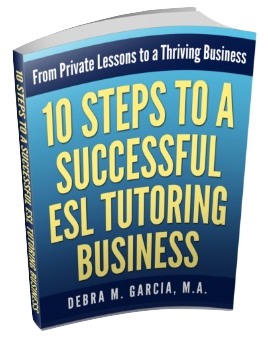Past Perfect Continuous Tense
How to Teach the Past Perfect Continuous
Tense to ESL/EFL Students
The Past Perfect Continuous tense is also called the Past Perfect Progressive tense.
ESL and EFL students often have difficulty with this verb tense due to its lengthy construction and the fact that they don't often get the opportunity to practice.
Thorough Past Perfect Progressive lesson plans must include these three elements:
~Conjugation,
~Form, and
~Function.
However, not all of these elements need to be included in one lesson, and in fact, it is best to present these over a few classes.
This page describes each of these components in greater detail to help teachers and tutors prepare the best lesson plans.
Past Perfect Continuous Conjugation
The Past Perfect Continuous/Past Perfect Progressive tense is constructed this way:
- subject + had been + -ing
The conjugation is fairly simple because only the subject changes.
Here are some examples with the subject pronouns I, you, he/she/it, they and we.
- I had been talking. I had been walking. I had been dancing. I had been eating.
- You had been talking. You had been walking. You had been dancing. You had been eating.
- She/He/It had been talking. She/He/It had been walking. She/He/It had been dancing. She/He/It had been eating.
- They had been talking. They had been walking. They had been dancing. They had been eating.
- We had been talking. We had been walking. We had been dancing. We had been eating.
Past Perfect Continuous Forms (five forms ESL/EFL students must learn)
- Affirmative Usage (I had been studying. You had been studying. She/He/It had been studying. They had been studying. We had been studying.)
- Negative Usage (I hadn't been learning. You hadn't been learning. She/He/It hadn't been learning. They hadn't been learning. We hadn't been learning.)
- Yes/No Questions (Had I been reading? Had you been reading? Had she/he/it been reading? Had they been reading? Had we been reading?)
- Short Answers (Yes, I had. No, I hadn't. Yes, you had. No, you hadn't. Yes, she/he/it had. No, she/he/it hadn't. Yes, they had. No, they hadn't. Yes, we had. No, we hadn't.)
- WH- Questions (e.g., When had she been studying EFL? Why had you been running? Where had they been going?)
Note: "Been" is sometimes added to the Short Answer form; e.g., Yes, I had been.
Past Perfect Continuous Function
The Past Perfect Continuous has two main functions.
- To emphasize the duration of an activity that was in progress before another activity or time in the past.
- To express an activity that was in progress close in time to another activity or time in the past.
- For example, I had been waiting for them for thirty minutes before they finally showed up.
- For example, She was all wet because she had been jogging in the rain.
ESL Student Challenges
ESL and EFL students often have trouble with this verb tense because it is usually one of the last tenses taught to students, so they often don't get enough practice with the tense. The other problem is that it takes a while to get used to the long construction of the verb tense ("subject + had been + present participle").
As with most English grammar verb tenses, practice and drills will help to reinforce the structure of the Past Perfect Continuous tense.
Related Article
For a thorough discussion on how to teach verb tenses, see Teaching ESL Verb Tenses.
Additional Resource
Azar's, Understanding and Using English Grammar is an excellent textbook for teaching the Past Perfect Continuous tense and all other verb tenses. I use it regularly with my students. It includes exercises and excellent explanations and is best for intermediate and advanced ESL/EFL learners.
From Past Perfect Continuous Tense
to Teaching ESL to Adults Home Page


New! Comments
Have your say about what you just read! Leave me a comment in the box below.